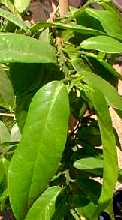View crop
View crop Data sheet EcoPortAntidesma bunius
 |
|
| Notes |
|---|
| BRIEF DESCRIPTION A small to medium-sized tree reaching 3-10 m or even up to 30 m in height, with a straight trunk, usually branched near the base. Leaves distichous, oblong-lanceolate, 19-25 x 4-10 cm, and fruits globose or ovoid drupe, 8-10 mm in diameter, yellowish-red to bluish-violet and juicy. USES The ripe fruit can be eaten raw or made into preserves, jams, jellies, sauce for fish, a refreshing drink or wine. It is also used in brandy and syrups. Young leaves are used to flavour fish and meat stew and both immature fruit and young leaves serve as substitutes for vinegar. Young leaves can be eaten in salads and cooked with rice. Bark and leaves have medicinal properties but can also be poisonous. The wood can be used for paper pulp. The tree can be used for reclamation of degraded and lang-lang infested areas and it can be planted as an ornamental. GROWING PERIOD Perennial. Seedlings bear fruit 4-5 years after planting. The fruiting season lasts only two months. COMMON NAMES Bignay, Chinese laurel, Salamander tree, Antidesme, Buni, Wuni, Huni, Buneh, Paginga, Isip, Kho lien tu, Baa mao ruesee, Mamao dong, Mao chaang, Choi moi. FURTHER INF Scientific synonym: A. rumphii, A. dallachyanum, Stilago bunius. Bignay occurs wild in the wetter parts on India, Sri Lanka, Myanmar and Malaysia. In the tropics, it can be found at elevations between sea level and 1000 m. The tree is common in the early stages of secondary forest succession, invading marginal grassland, but attains optimal growth under partial shade. Annual fruit yields may be 250-400 kg per tree. | Sources |
| Verheij E 1991 pp 78-79 [USE, TEXT, DRA, LIG] Roecklein J 1987 pp 201 [USE] Duke J 1975 pp 7 [PH, TEMP, RAIN] Rehm S 1991 pp 218 [USE] Purseglove J 1974 pp 139 [USE] |